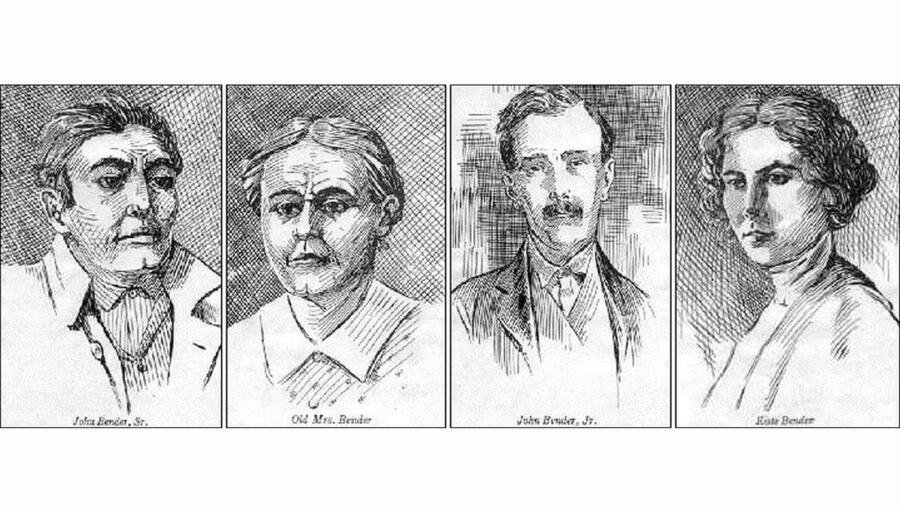In the lawless wilds of 1870s frontier Kansas, a gruesome tale unfolded that would earn one family infamy as America’s first serial killing clan. The so-called Bloody Benders—a quartet posing as a kind, welcoming family—used their rural inn in Labette County as a house of death. From 1870 to 1873, travelers entered their cabin seeking rest but never walked out again.
While the Benders are believed to have murdered at least 11 people, many suspect the actual number could be far higher. Even more unsettling? They disappeared without a trace, evading capture and vanishing into the fog of history.
A Killer Family—or Just a Calculated Lie?
The Bender household included four individuals:
- “Ma” Bender (whose real name remains unknown)
- “Pa” Bender
- Kate Bender, a self-styled spiritualist
- John Gebhardt, who passed as Kate’s brother
However, were they really a family?
Historian Susan Jonusas, author of Hell’s Half-Acre: The Untold Story of the Benders, doesn’t think so. “It’s likely Kate and Ma were mother and daughter,” she explains. “But Kate and Gebhardt acted more like lovers than siblings.”
On the violent frontier, posing as a wholesome family unit helped the Benders blend in. Settlers often trusted family-run businesses, which made it easier for the Benders to lure victims without suspicion.
The Trap Disguised as Hospitality
Located near the Osage Trail, their inn was a prime stop for travelers. At first glance, it offered food, shelter, and spiritual healing services—Kate often held séances and gave lectures on free love. But the real business was far darker.
Jonusas speculates the murders may have begun accidentally during a robbery. When no one came looking for the victim, the Benders realized they could kill and get away with it. Encouraged by the silence, they turned their inn into a killing ground.
What the Benders Did Inside That Cabin
The Benders had a chilling routine. Victims were invited to sit at the dining table, which sat over a trapdoor. As they ate, one of the men would strike the guest from behind with a hammer, while another would slash the throat to ensure death. The body was then dumped through the trapdoor into the cellar before being buried in the orchard.
When authorities searched the property in 1873 after the Benders fled, they unearthed eight bodies in the orchard and three more nearby, all showing blunt force trauma and throat wounds. One grave contained a woman and her child, still in her arms.
Was Kate the Killer? Or the Manipulator?
At the time, sensational newspapers painted Kate Bender as the seductive, spell-casting mastermind. Some claimed she performed spiritual rituals before murders, while others believed she was the actual executioner.
Jonusas offers a more grounded analysis. “It’s unlikely Kate or Ma delivered the fatal blows. Most violent acts came from Gebhardt and Pa. Kate likely played a psychological role, distracting or calming victims before the attack.”
How Did They Escape Justice?
In April 1873, suspicion grew after several prominent travelers went missing. When lawmen finally reached the inn, the Benders were gone.
Although manhunts stretched across the country, the Benders were never found. Some claimed they were spotted in Texas or Wyoming, while others believed vigilantes captured and killed them.
Strangely, documents later revealed that authorities had leads on their whereabouts for 18 months. However, no resources—or perhaps no political will—were available to follow through. Even appeals to the military for help were dismissed.
Mistaken Identities and Lingering Legends
In 1889, two women named Almira Monroe and Sarah Davis were arrested in Michigan, suspected of being Ma and Kate Bender. Despite national interest and a sensational trial, the women were released when solid alibis emerged.
The Benders remained ghosts—real people turned into legendary monsters.
Copycats or Survivors? The Kelly Family Theory
In 1887, a new killer family emerged in Kansas: The Kellys, accused of similar crimes. Rumors swirled that the Benders had returned under new identities. However, Jonusas dismisses this as myth.
“There’s no solid evidence the Benders became the Kellys,” she explains. “But I do believe they kept killing. Their crimes were too methodical to stop cold.”
Legacy of America’s First Serial Killer Family
The Bender house became a ghoulish attraction. Tourists ransacked the property, taking floorboards, bricks, and even pieces of the walls as “souvenirs.” Some wanted relics, others just needed to see the place where so much horror occurred.
In the end, the Bloody Benders left behind more questions than answers. How many did they really kill? How did they evade capture in an age of wanted posters and telegraphs? And most hauntingly—did they kill again under different names?
We may never know. But the shadow of America’s first serial killing family still lingers in Kansas soil.
FAQs
Who were the Bloody Benders?
The Bloody Benders were four individuals posing as a family who murdered travelers in Kansas during the early 1870s.
How many people did the Benders kill?
They are confirmed to have murdered at least 11 people, although the true number may be higher.
What was their motive?
Their primary motive was robbery, though many believe they also enjoyed the power and violence.
Why weren’t they caught?
The Benders fled their cabin before law enforcement could arrest them. Despite a national manhunt, they were never found.
Did they kill again?
Some believe they continued killing under new identities. However, this theory remains unproven.
Was Kate Bender really a killer?
She likely played a supporting or manipulative role, but historians believe Gebhardt and Pa carried out most of the actual violence.

